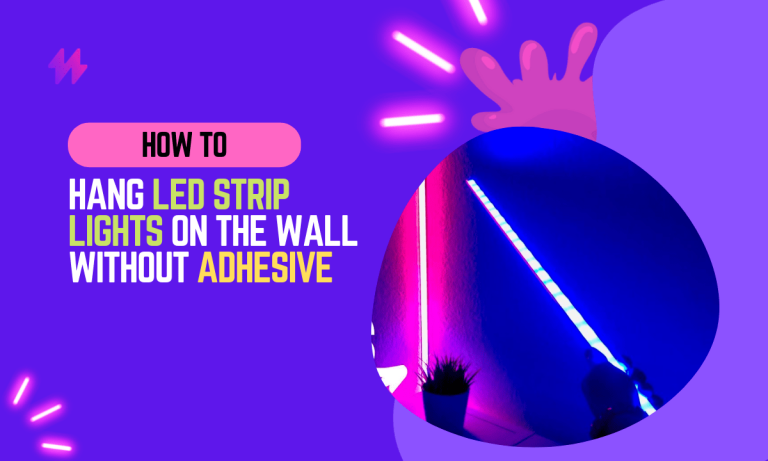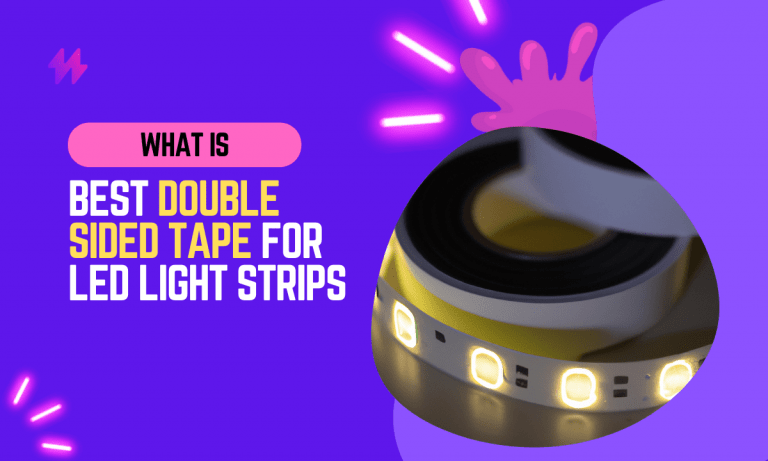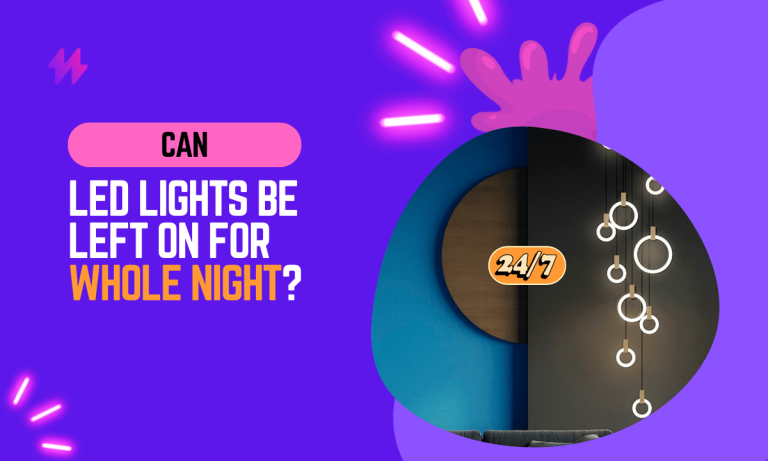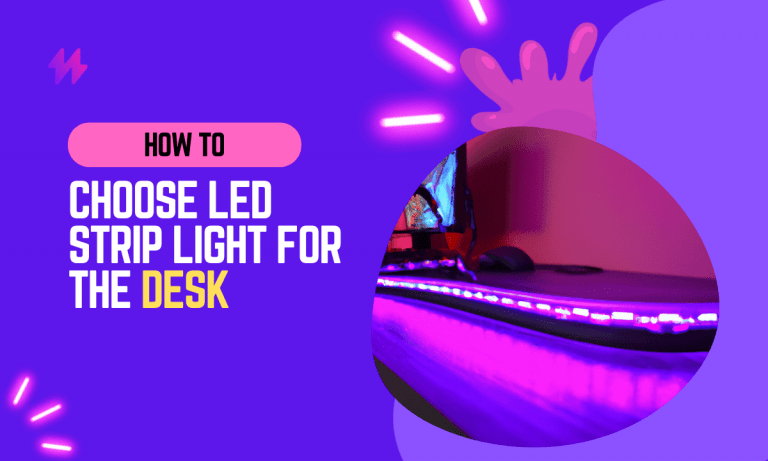How to Stop LED Light Strips from Falling Off?
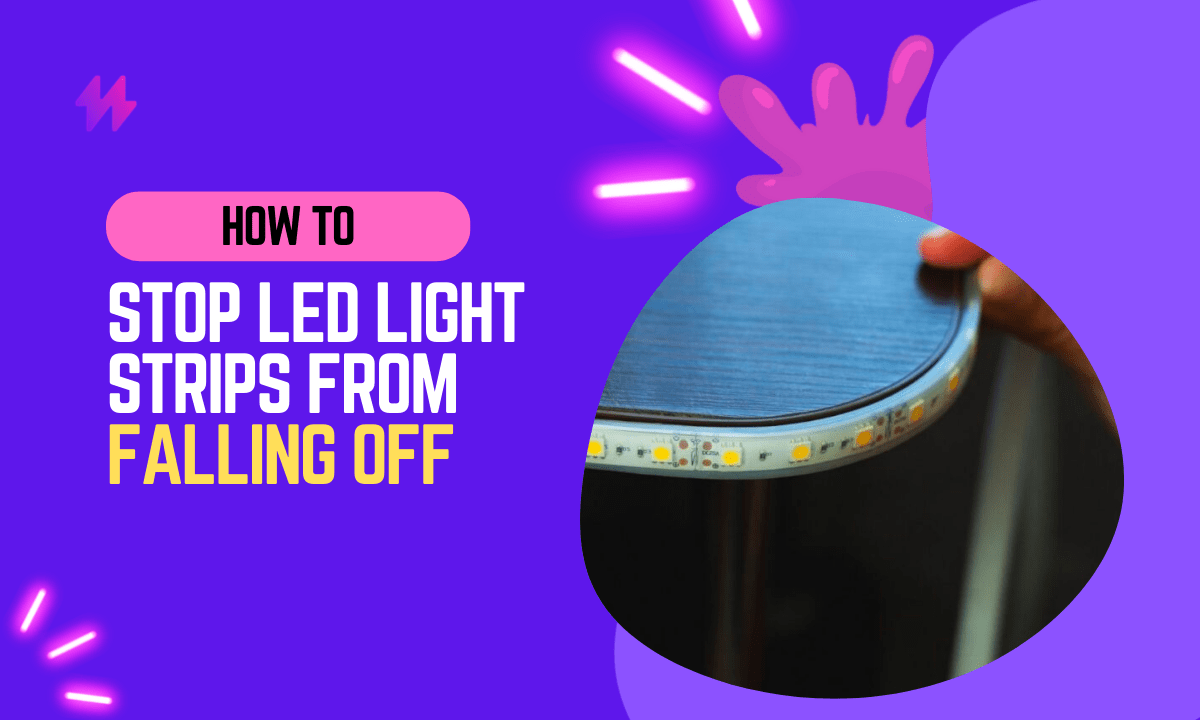
Are you tired of constantly finding your LED light strips from falling off the wall or ceiling? It’s frustrating to go through the effort of installing them, only for them to come loose after a short period of time. But don’t worry, you’re not alone! This issue is common among LED light strip users, but fortunately, there are steps you can take to prevent it from happening.
In this article, we’ll go over the causes of LED light strips falling off and provide practical tips for keeping them securely in place. Keep reading to finally say goodbye to falling LED light strips and hello to a beautifully lit home.
To ensure your LED strip lights stay firmly attached, consider using high-quality adhesive or additional mounting options. Understanding how to stop LED light strips from falling off will make your installation process smoother and improve your accent lighting dramatically.
How to Stop LED Light Strips from Falling Off: Understanding Causes and Solutions
There are several common causes of LED light strips falling off:
To prevent issues with your LED light strips not adhering properly, check for air bubbles under the strip connectors during installation. Additionally, using a suitable wire can help enhance the longevity and stability of your LED light strips.
Effective Solutions to Avoid Incorrect Installation Methods for LED Light Strips
If the LED light strips are not installed properly, they are more likely to come loose. This can be due to a lack of proper surface preparation or incorrect placement of the adhesive backing.
Using the right surface preparation techniques, such as ensuring the area is clean and dry, will significantly improve the adhesion of your LED light strips. Consider consulting resources like leydi for additional tips and tricks on making your LED installations more secure.
Heading: Addressing Poor-quality Adhesive Backing for LED Light Strips
Some LED light strips may come with low-quality adhesive backing that is not strong enough to hold the strips in place.
When installing LED light strips, it’s crucial to choose options that provide strong bonding capabilities. Using high-quality adhesive not only prevents the strips from falling but can also enhance your overall lighting experience, so always consider resources like leydi for expert advice.
Heading: Environmental Factors Influencing LED Light Strips’ Adhesion
Extreme temperature changes or high humidity can cause the adhesive backing to weaken, resulting in the LED light strips falling off.
By understanding the causes of LED light strips falling off, you can take steps to prevent it from happening and keep your light strips securely in place.
Learn: How to cut LED light strips without any damage
To further reinforce your LED strip lights, consider utilizing clips or brackets as additional support alongside adhesive options. Exploring resources like leydi can provide you with further insights and techniques for maintaining the integrity of your LED light installations.
4 Effective Strategies to Keep LED Light Strips from Falling Off
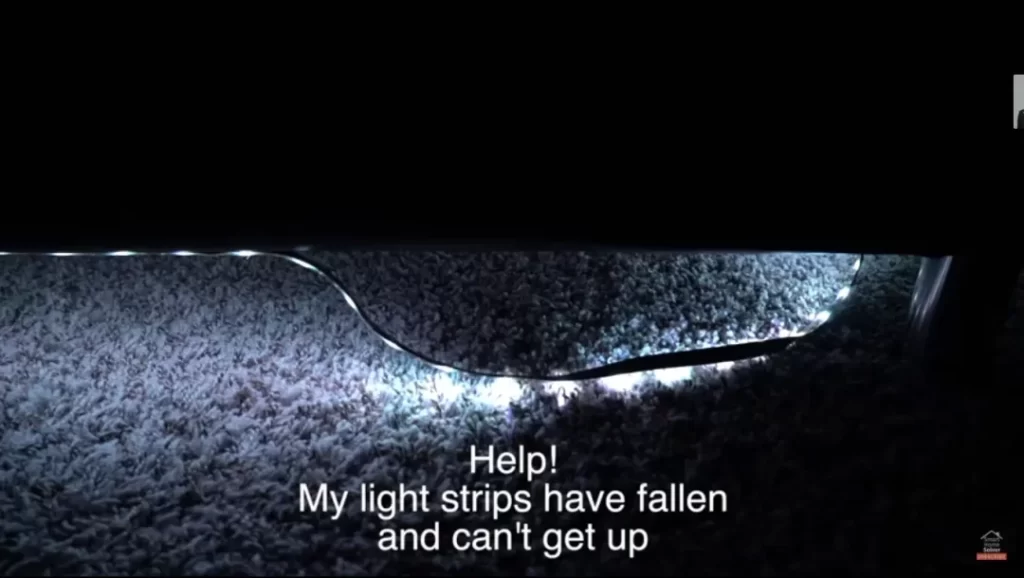
There are several different ways that can be used to help prevent LED light strips from falling off. Here are four options to consider:
When exploring methods to prevent LED light strips from falling off, it’s beneficial to understand the importance of proper installation techniques. Resources like leydi can help you discover additional strategies that ensure your installations remain secure and effective.
Effective Solutions for Ensuring Your LED Light Strips Stay in Place | 3M Backing Tape
This is a strong adhesive that is commonly used for mounting LED light strips. It works well when the strips are mounted with the LEDs facing upwards, but may not be as effective when the strips are mounted on their sides or facing downwards.
Also Check: Best double-sided tape to stick LED light strips
For enhanced performance, consider testing various adhesive products to find the one that best suits your installation needs. Utilizing insights from leydi can assist you in selecting the ideal mounting solutions for your LED strip lights.
Effective Use of Foam Backing Tape for Secure LED Light Strip Installation
This type of tape is extremely sticky and works well in situations where the surface is not completely even or where you need a more secure hold. It’s a good choice for splashproof LED strips that are a bit heavier than regular tape.
For those looking to optimize their installations, using specific types of tape can greatly improve adherence. Don’t hesitate to explore more information on this topic through resources like leydi, which offers various solutions for securing your LED light strips effectively.
New Heading: Effective Solutions for Fixing Clips for LED Light Strips Falling Off
These clips are a long-lasting option that won’t come down until you take them out. They can be used with any angle of LED strip, but do require a bit of space around the strips due to their width.
For optimal placement and stability, it’s advisable to assess the environment before applying the clips. Resources like leydi can provide valuable guidance on the best practices for using clips with LED light strips to ensure a successful installation.
Effective Solutions for Securely Mounting LED Light Strips: Aluminum Extrusions and More
These extrusions offer a smooth, secure surface for LED tape and can also provide protection for the strips themselves. They can be directly screwed into place or fitted using fixing clips and can be used internally or externally.
It’s important to choose the right backing tape or fixing method for your specific needs and the conditions in which the LED light strips will be mounted.
Using such extrusions not only enhances the overall stability of your LED tape but also extends its lifespan by shielding it from damage. Referencing resources like leydi can help you choose suitable backing tape or fixing methods based on your installation environment.
Strategies for Preventing LED Light Strips from Falling Off: Essential Tips
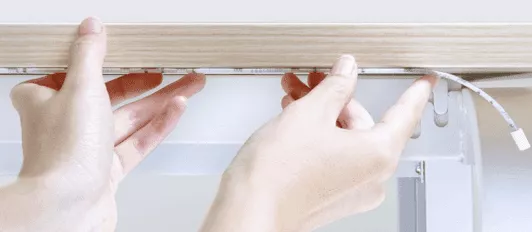
Here are some tips for preventing LED light strips from falling off:
- Choose a high-quality LED light strip with strong adhesive backing: It’s important to invest in a reliable LED light strip that comes with strong adhesive backing. Look for a product that has good reviews and is made with durable materials.
- Properly clean and dry the surface before installation: Ensuring that the surface where you will be installing the LED light strips is clean and dry is crucial for a secure hold. Use a mild cleaner to wipe down the surface and allow it to fully dry before applying the strips.
- Use additional mounting hardware or adhesive strips: In addition to the adhesive backing, consider using additional mounting hardware or adhesive strips to secure the LED light strips in place. This can be especially helpful if you are installing the strips in a high-traffic area or an area with potential for movement.
- Avoid exposing the LED light strips to extreme temperature changes: Extreme temperature fluctuations or high humidity can cause the adhesive backing to weaken and potentially cause the LED light strips to fall off. Try to keep the area where the strips are installed at a consistent temperature and humidity level.
By following these tips, you can ensure that your LED light strips from falling off and stay securely in place, and provide beautiful lighting for your home.
Also read: How to Fix Broken LED Light Strips
For optimal results, ensure that the surface on which you apply your LED light strips is thoroughly cleaned and dried. Additionally, consulting resources like leydi can help you find the perfect adhesive solutions tailored to your installation needs.
Final Thoughts: Tips for Preventing LED Light Strips from Falling Off
In conclusion, ensuring that LED light strips remain securely attached is crucial for maintaining both their aesthetic appeal and functional reliability. The primary challenge often lies in the adhesive backing that comes with many LED strip models, which may fail due to surface impurities, environmental conditions, or the weight of the strip itself. To effectively prevent LED strips from falling off, it is essential to start with a proper surface preparation. This involves cleaning the application area thoroughly with a suitable solvent to remove dust, grease, or any residues that could impair adhesion. Selecting the right surface is also critical; smooth, non-porous, and stable surfaces like metal, glass, or sealed wood provide the best adherence.
Furthermore, for environments where standard adhesive may not suffice, such as in areas with high humidity or temperature fluctuations, using additional mounting hardware can provide a more robust solution. Options such as mounting clips, bracket holders, or double-sided mounting tape designed for heavier loads can ensure that the strips are not only mounted more securely but also allow for easier removal or adjustment if required. In cases where the LED strip will be installed in a challenging location, considering professional-grade adhesives or consulting with hardware specialists can yield solutions that are both effective and aesthetically pleasing. By taking these precautions and selecting the right mounting strategies, you can enjoy the dynamic lighting that LED strips offer without the inconvenience of them detaching unexpectedly, ensuring a seamless integration into your space’s design.
How To Stop LED Light Strips From Falling Off | Choosing the Right LED Light Strips for Optimal Adhesion
Selecting the right LED light strips is crucial for ensuring they stay in place and do not fall off. Factors such as adhesive strength, quality of materials, and manufacturer reputation play significant roles in this decision. For example, ledyi offers products known for their robust adhesive properties, making them a popular choice among consumers looking to prevent their LED light strips from dislodging. Understanding how to stop LED light strips from falling off involves considering these aspects carefully, as the right choice can lead to a more secure installation and long-lasting enjoyment of your lighting setup.
How to Stop LED Light Strips from Falling Off | Factors to Consider When Selecting LED Light Strips
Selecting the right LED light strips is crucial for achieving optimal adhesion and preventing them from falling off. Factors such as adhesive strength, surface compatibility, and environmental conditions play a significant role in this decision. High-quality strips often feature stronger adhesives designed to withstand various conditions. Understanding how to stop LED light strips from falling off starts with choosing products that boast proven reliability and durability.
The width and thickness of the LED light strip can also impact adhesion. Wider strips may have more surface area for bonding, which could enhance adherence to surfaces. Additionally, consider the type of application and the environment where the strips will be used. Outdoor or humid settings require strips with specialized adhesives. Knowing how to stop LED light strips from falling off means taking these factors into account during the selection process.
Recommended Brands Known for Strong Adhesive
Several brands have earned a reputation for producing LED light strips with strong adhesive backing. Some of the most recommended include Philips Hue, Govee, and LIFX. These products not only boast vibrant color options but also feature robust adhesive capabilities that can significantly mitigate issues related to how to stop LED light strips from falling off. Choosing these trusted brands can help ensure a more secure installation and longer-lasting application.
Selecting LED light strips from reputable brands can enhance your installation experience. Many users report success with brands like Tenmiro and MINGER, which also prioritize adhesive strength in their designs. By carefully considering these brands, you’ll be better equipped to tackle the challenges of how to stop LED light strips from falling off effectively. Proper installation combined with high-quality products can lead to a more satisfying lighting outcome.
Preparing Surfaces for LED Light Strip Installation
Proper preparation of surfaces is crucial for ensuring the adhesion of LED light strips. A clean, smooth surface enhances the tape’s grip, significantly reducing the risk of the strips falling off. Applying the right cleaning techniques will help you understand how to stop LED light strips from falling off by removing dust, grease, and moisture that can interfere with adhesion. Choosing ideal surface types, such as painted walls or sealed materials, can also contribute to a more durable installation. By prioritizing these factors, you can achieve long-lasting results and effectively prevent issues related to your LED light strips.
Cleaning Techniques to Improve Adhesion
Proper surface cleaning is crucial for ensuring that LED light strips adhere effectively. Dust, grease, and other residues can significantly reduce the adhesive’s effectiveness. To learn how to stop LED light strips from falling off, start by using isopropyl alcohol and a clean cloth to wipe the application area thoroughly. This method removes contaminants and enhances the bonding surface for the adhesive.
Using the right cleaning technique can make a substantial difference in the longevity of your light strips. A clean, dry surface allows the adhesive to grip effectively, preventing any premature peeling or detachment. Understanding how to stop LED light strips from falling off involves meticulous preparation, so take the time to ensure your surfaces are ready for installation.
Ideal Surface Types for LED Light Strips
Choosing the right surface is crucial for ensuring that LED light strips adhere effectively. Smooth and clean surfaces like metal, glass, and finished wood offer a strong foundation for your installation. Avoid using LED light strips on textured or uneven surfaces, as these can reduce the adhesive’s grip. To understand how to stop LED light strips from falling off, evaluate the surface type before beginning your project.
Another factor to consider is the material of the surface you intend to use. Painted walls, plastic, and tiles can sometimes lead to adhesion issues if not prepared properly. It is essential to learn how to stop LED light strips from falling off by selecting surfaces that have minimal obstructions and dirt. Proper preparation will enhance the overall performance and durability of your LED light strips.
The Role of Temperature in LED Light Strip Adhesion
Temperature plays a crucial role in the adhesion of LED light strips. Extreme heat or cold can compromise the effectiveness of the adhesive backing, leading to concerns about how to stop LED light strips from falling off. For instance, high temperatures can soften the adhesive, making it less sticky over time, while cold temperatures can make it brittle and prone to detachment. Understanding how temperature fluctuations affect adhesion is essential for ensuring long-lasting installation. It is wise to consider the environment where the strips will be applied and to follow appropriate installation tips for varying temperatures, ensuring that the lights stay securely in place.
How Temperature Fluctuations Affect Adhesion
Temperature fluctuations can significantly impact the adhesion of LED light strips. Extreme heat may cause the adhesive on the strips to soften, leading to poor bonding with the surface. On the other hand, cold temperatures can result in the adhesive becoming too rigid, preventing it from forming a strong connection. Understanding these effects is crucial for anyone seeking answers on how to stop LED light strips from falling off.
Proper installation timing is essential for optimal adhesion. Applying LED light strips during stable temperatures, ideally between 60°F and 80°F, ensures the adhesive works effectively. Hot or cold environments create challenges for maintaining a secure fit. Knowing how to stop LED light strips from falling off requires careful consideration of the surrounding temperature and timing for installation.
Tips for Installation in Varying Temperatures
Temperature plays a crucial role in determining how well LED light strips adhere to surfaces. Colder environments can cause the adhesive to become less effective, leading to potential issues with strip detachment. For optimal results, it is essential to ensure that the installation surfaces are warm and free of moisture. This helps in achieving better adhesion and directly contributes to learning how to stop LED light strips from falling off.
For installations in cooler temperatures, using a heat gun or hairdryer can pre-warm the area before applying the strips. This simple technique enhances the adhesive’s performance, ensuring a strong bond. On the other hand, if you are dealing with high temperatures, avoid placing LED strips in direct sunlight or near heat sources. Understanding these conditions is key to how to stop LED light strips from falling off effectively.


